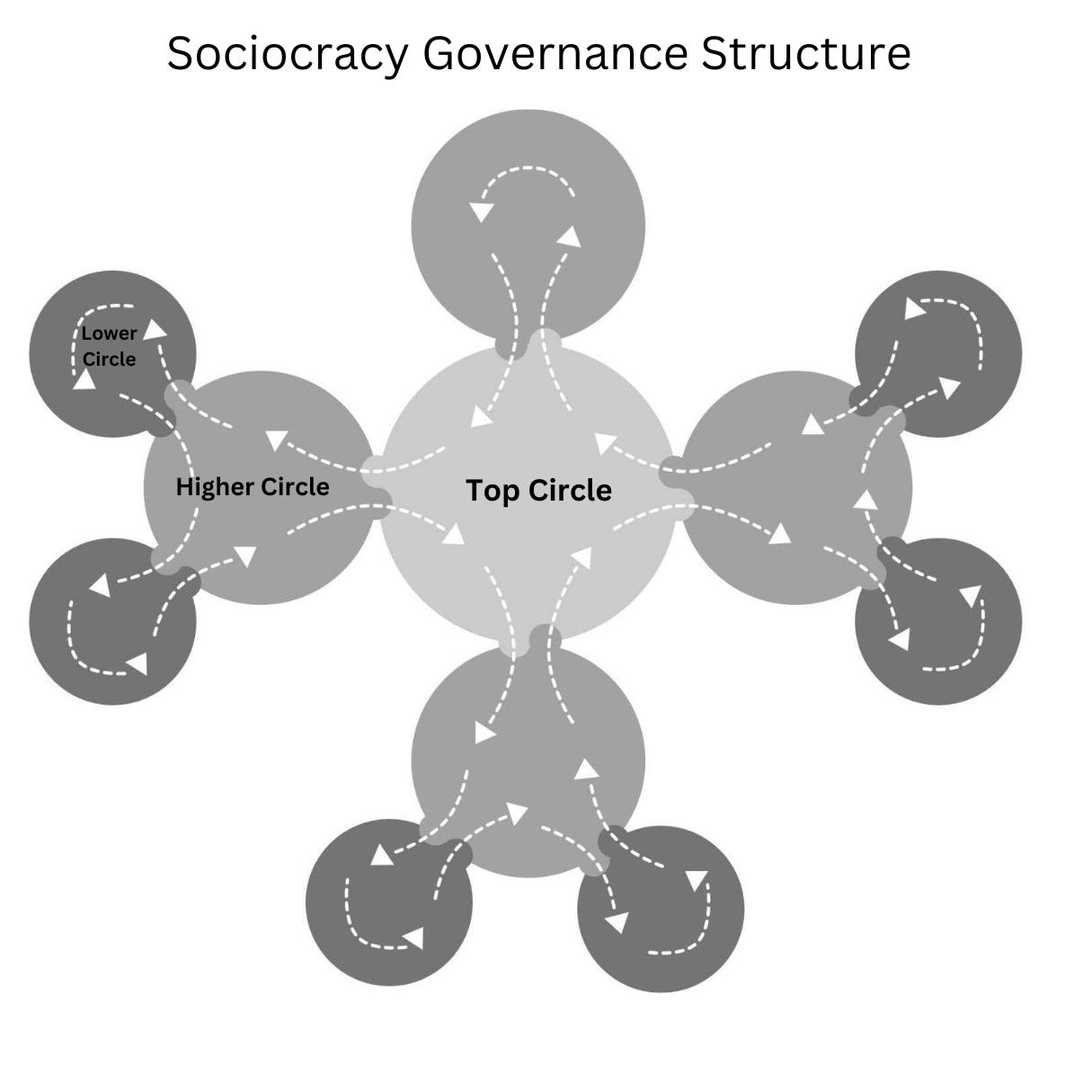glossary
Sociocracy
Governance GlossaryPublished: December 6, 2023

Sociocracy is founded on the idea that a more equal and democratic structure can create better work conditions and a more coherent system. As an organisational structure, sociocracy is used to create a balance between team member interdependence and autonomy. This approach can be more beneficial for making decisions than a traditional hierarchy that works from the top down.
According to Sociocracyforall.org, sociocracy is a ‘peer governance system based on consent’. As an organisational structure, it allows leaders to develop trusted teams with an ability to collaborate and participate in decisions that affect them. Decisions are made by circles of people, each with their own purpose and authority. The approach creates a decentralized power dynamic that gives employees a strong mechanism for sharing feedback and suggestions for improvements.
The main benefit of adopting sociocratic governance is that no one is ignored, and the organisation can achieve improvement over time. Other benefits are having more opportunities for professional development and leadership development, better delegation of work, and more cooperation.
Sociocracy Principles
There are three basic principles to leadership through sociocracy. The first is the principle of consent. Decisions are made with the consent of those they affect directly and are approved when there are no objections. The second tenant is the principle of circles. Governance is done through a circular hierarchy rather than a top-down approach. Circles are semi-autonomous and self-organizing and are created to delegate responsibilities in specific domains of expertise.
The third principle is the double link. Circles still have a structure that involves lower and higher-level decisions and responsibilities. Each circle is linked together by one representative, the circle officer, who attends both group meetings. This double link creates a connection between both working groups and encourages information sharing. Authority can be shared across several circles and helps create transparency. When a circle member objects to a proposal, the issue is discussed until everyone is satisfied with the result.
Sociocracy is built on a governance method that allows leaders to share responsibility for policy making with others, which creates equity between team members and recognizes experts within the organisation. Board members still have the authority to manage and direct the organisation, oversee the strategic plan, and provide financial oversight. As the top circle, the board ensures the organisation develops and functions well. Board members make their decisions by consent, which requires a higher number than a majority vote.
Sociocracy governance structure
Sociocracy structure is flexible and can be tailored to the needs of the organisation, which can change over time. The circles are created with a purpose and are each assigned a different role. Circle members work together on various parts of the business and must select a secretary to record decisions, a facilitator to manage the meetings, a circle leader to coordinate operations within the circle, and a circle officer who shares information with the parent circle.

Each circle member is assigned a role, and one person can have several within their group. At every level, each circle makes its own decisions about an issue related to its domain. Rather than having a central committee that runs the entire organisation. the small teams each have authority over their domain and don’t require permission from the top circle. However, they do need to communicate with other circles when their goals are related.
The Board of Directors typically have more power and represents the ‘top circle’ in the organisation. The top circle is sometimes considered the mission circle and consists of board members who drive the mission of the organisation. All circle officers have an important role in creating linkages between the two circles and making sure information flows freely across the organisation. Some organisations create a coordinating circle made of representatives from the other teams. Others use a general circle that supports other circles with their work and everyday tasks.
What is the main sociocracy criticism?
An organisation with a structure based on sociocracy must make decisions by consent. This means problem solving is done collaboratively and everyone can share their opinion. In comparison, a traditional hierarchy has clear boundaries between the top and other levels when it comes to authority and reporting. Sociocracy leadership works well in organisations that have clear policies about how decisions are made about how work is done.
However, new organisations may need to do more work to define their workflows, systems, and collaborative processes such as training staff on how to make decisions by consent. When circle members understand the operations side of the work and have expertise and experience in their domain, sociocracy can be an effective governance structure. However, circle priorities may conflict with the rules, principles, or methods of other circles, creating the challenge of having to negotiate decisions and planning for as long as it takes.
What is the difference between consent vs consensus?
Consensus decision making is the process of reaching an agreement by working together to find a mutually acceptable solution. It involves agreeing as a group rather than voting and deciding based on what the majority wants. The intention is inclusiveness and accountability, but consensus involves more facilitation and flexibility, and a willingness to share control.
Consent decision-making is similar to consensus. All group members get to choose whether they agree with the decision or not. The process involves finding a balance between your preference and what you’re willing to tolerate. Consent-based decisions are meant to avoid creating a right/wrong dynamic in the group and can encourage common ground between people.
What are the rules and processes for making decisions?
Sociocratic leadership includes bylaws and consent-based decisions. Instead of needing a majority vote of 51% or more, decisions are made by discussing the issue or proposal. Circle meetings typically happen every three months as part of the organisation’s strategy to evaluate effectiveness, review policies, and recommend or make changes.
Decisions are made during ‘rounds’, which consist of each person speaking one after the other to make sure everyone has been heard. Rounds are intended to create group cohesion and a more democratic approach to operating the organisation. Circle members are assigned their roles through consent rounds, and the secretary is responsible for record-keeping and maintaining a logbook. The circle objectives are determined by the higher circle.
For information on how to manage meetings and record decisions, visit Better Boards’ Our Cat Herder board portal.
Recommended Reading
Recommended Viewing
Author
- About
-
Better Boards connects the leaders of Australasian non-profit organisations to the knowledge and networks necessary to grow and develop their leadership skills and build a strong governance framework for their organisation.
Found this article useful or informative?
Join 5,000+ not-for-profit & for-purpose directors receiving the latest insights on governance and leadership.
Receive a free e-book on improving your board decisions when you subscribe.
Unsubscribe anytime. We care about your privacy - read our Privacy Policy .










